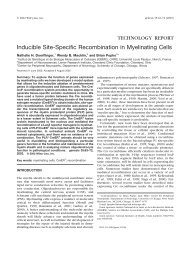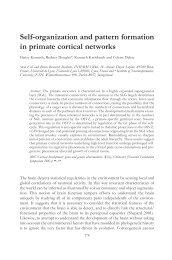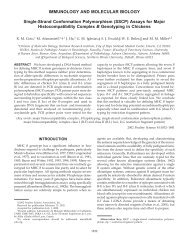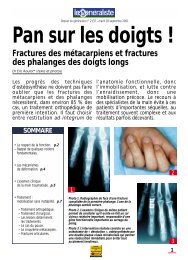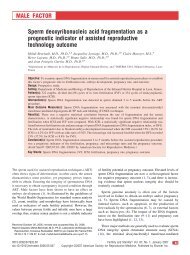Host Circadian Clock as a Control Point in Tumor Progression
Host Circadian Clock as a Control Point in Tumor Progression
Host Circadian Clock as a Control Point in Tumor Progression
- No tags were found...
You also want an ePaper? Increase the reach of your titles
YUMPU automatically turns print PDFs into web optimized ePapers that Google loves.
<strong>Host</strong> <strong>Circadian</strong> <strong>Clock</strong> <strong>as</strong> a <strong>Control</strong> <strong>Po<strong>in</strong>t</strong> <strong>in</strong> <strong>Tumor</strong><br />
<strong>Progression</strong><br />
Elisabeth Filipski, Verdun M. K<strong>in</strong>g, XiaoMei Li, Teresa G. Granda,<br />
Marie-Christ<strong>in</strong>e Mormont, XuHui Liu, Bruno Claustrat, Michael H. H<strong>as</strong>t<strong>in</strong>gs,<br />
Francis Lévi<br />
Background: The circadian tim<strong>in</strong>g system controlled by the<br />
suprachi<strong>as</strong>matic nuclei (SCN) of the hypothalamus regulates<br />
daily rhythms of motor activity and adrenocortical secretion.<br />
An alteration <strong>in</strong> these rhythms is <strong>as</strong>sociated with poor survival<br />
of patients with met<strong>as</strong>tatic colorectal or bre<strong>as</strong>t cancer.<br />
We developed a mouse model to <strong>in</strong>vestigate the consequences<br />
of severe circadian dysfunction upon tumor growth. Methods:<br />
The SCN of mice were destroyed by bilateral electrolytic<br />
lesions, and body activity and body temperature were<br />
recorded with a radio transmitter implanted <strong>in</strong>to the peritoneal<br />
cavity. Pl<strong>as</strong>ma corticosterone levels and circulat<strong>in</strong>g<br />
lymphocyte counts were me<strong>as</strong>ured (n = 75 with SCN lesions,<br />
n = 64 sham-operated). Complete SCN destruction w<strong>as</strong> <strong>as</strong>certa<strong>in</strong>ed<br />
postmortem. Mice were <strong>in</strong>oculated with implants<br />
of Gl<strong>as</strong>gow osteosarcoma (n = 16 with SCN lesions, n = 12<br />
sham-operated) or pancreatic adenocarc<strong>in</strong>oma (n = 13 with<br />
SCN lesions, n = 13 sham-operated) tumors to determ<strong>in</strong>e the<br />
effects of altered circadian rhythms on tumor progression.<br />
Time series for body temperature and rest–activity patterns<br />
were analyzed by spectral analysis and cos<strong>in</strong>or analysis.<br />
Parametric data were compared by the use of analysis of<br />
variance (ANOVA) and survival curves with the log-rank<br />
test. All statistical tests were two-sided. Results: The 24-hour<br />
rest–activity cycle w<strong>as</strong> ablated and the daily rhythms of serum<br />
corticosterone level and lymphocyte count were markedly<br />
altered <strong>in</strong> 75 mice with complete SCN destruction <strong>as</strong><br />
compared with 64 sham-operated mice (two-way ANOVA<br />
for corticosterone: sampl<strong>in</strong>g time effect P
elevance of this pr<strong>in</strong>ciple w<strong>as</strong> demonstrated <strong>in</strong> multicenter randomized<br />
trials, <strong>as</strong> the tolerability of mucosae and that of sensory<br />
nerves were improved fivefold and twofold, respectively, with<br />
chronomodulated chemotherapy <strong>as</strong> compared with drug <strong>in</strong>fusion<br />
at a constant rate. Moreover, the antitumor activity of the chronotherapy<br />
regimen also showed enhancement that w<strong>as</strong> statistically<br />
significant (P
<strong>in</strong> the donor mice and kept <strong>in</strong> Hanks’ medium for approximately<br />
1 hour. They were freshly implanted subcutaneously <strong>in</strong> each<br />
flank of male B6D2F 1 mice with a 12-gauge trocar. The experiment<br />
followed a2×2 factorial design to test the role of SCN<br />
lesions, that of tumor type, and an <strong>in</strong>teraction term, with regard<br />
to tumor growth and survival.<br />
<strong>Tumor</strong> size w<strong>as</strong> me<strong>as</strong>ured three times a week us<strong>in</strong>g a caliper.<br />
<strong>Tumor</strong> weight (mg) w<strong>as</strong> estimated from two perpendicular me<strong>as</strong>urements<br />
(mm): tumor weight (length × width 2 )/2.<br />
Mice with tumor weight reach<strong>in</strong>g approximately 2 g were<br />
sacrificed for ethical re<strong>as</strong>ons and considered <strong>as</strong> dead from tumor<br />
progression on this date. Four mice (two with SCN lesions and<br />
two sham-operated) were not <strong>in</strong>oculated with tumor and served<br />
<strong>as</strong> healthy controls.<br />
Statistical Analysis<br />
Means and 95% confidence <strong>in</strong>tervals were computed for each<br />
set of parameters. Intergroup differences were evaluated statistically<br />
us<strong>in</strong>g multiple-way analyses of variance (ANOVA). The<br />
effect of SCN lesions on tumor growth w<strong>as</strong> <strong>as</strong>sessed with 2-way<br />
ANOVA for repeated me<strong>as</strong>ures and followed by Student’s t test.<br />
Time series were analyzed by spectral analysis (Fourier transform<br />
analysis) us<strong>in</strong>g Mathcad 6.0. Statistical significance of circadian<br />
rhythmicity w<strong>as</strong> further documented by cos<strong>in</strong>or analysis<br />
(24). This method characterized a rhythm by the parameters of<br />
the fitted cos<strong>in</strong>e function best approximat<strong>in</strong>g all data. A period<br />
24 hours w<strong>as</strong> determ<strong>in</strong>ed a priori. The rhythm characteristics<br />
estimated by this l<strong>in</strong>ear le<strong>as</strong>t squares method <strong>in</strong>clude the<br />
mesor (M, rhythm-adjusted mean), the double amplitude (2A,<br />
difference between m<strong>in</strong>imum and maximum of fitted cos<strong>in</strong>e<br />
function), and the acroph<strong>as</strong>e (Ø, time of maximum <strong>in</strong> fitted<br />
cos<strong>in</strong>e function, with light onset <strong>as</strong> Ø reference, so that units<br />
were <strong>in</strong> HALO). A rhythm w<strong>as</strong> detected if the null hypothesis<br />
w<strong>as</strong> rejected with P
Journal of the National Cancer Institute, Vol. 94, No. 9, May 1, 2002 ARTICLES 693
operated mice. Cos<strong>in</strong>or analysis confirmed the marked alterations<br />
that SCN lesions produced <strong>in</strong> circadian rhythms <strong>in</strong> peripheral<br />
blood.<br />
Relevance of <strong>Circadian</strong> Coord<strong>in</strong>ation for <strong>Tumor</strong> Growth<br />
Fig. 2. Circulat<strong>in</strong>g corticosterone and lymphocyte rhythms <strong>in</strong> sham-operated<br />
mice and mice with lesions <strong>in</strong> suprachi<strong>as</strong>matic nuclei (SCN). Serum concentration<br />
of corticosterone (panel A) and lymphocyte count (panel B) are shown <strong>as</strong><br />
a function of sampl<strong>in</strong>g time. Each po<strong>in</strong>t represents the mean and 95% confidence<br />
<strong>in</strong>tervals of 10–11 sham-operated mice (solid circles) or 12–14 mice with SCN<br />
lesions (open circles). Sampl<strong>in</strong>g time is expressed <strong>in</strong> hours after light onset<br />
(HALO). <strong>in</strong>dicates the 12-hour light span and <strong>in</strong>dicates the 12-hour dark<br />
span. Two-way analysis of variance of the corticosterone data validated statistically<br />
significant effects of SCN lesion (P .001), sampl<strong>in</strong>g time (P
Fig. 3. <strong>Tumor</strong> growth <strong>in</strong> sham-operated and mice with lesions <strong>in</strong> suprachi<strong>as</strong>matic<br />
nuclei (SCN). Mean tumor weights are shown with their respective 95% confidence<br />
<strong>in</strong>tervals. <strong>Tumor</strong> growth <strong>in</strong> mice with Gl<strong>as</strong>gow osteosarcoma (GOS)<br />
(panel A) or pancreatic adenocarc<strong>in</strong>oma (P03) (panel B). Sham-operated mice<br />
are represented by solid circles and mice with SCN lesions by open circles.<br />
Accelerated growth of both tumors <strong>in</strong> mice with SCN lesions w<strong>as</strong> statistically<br />
validated with ANOVA (GOS, P .004; P03, P
development, our experimental model clearly demonstrates a<br />
specific role for the hypothalamic clock with regard to cancer<br />
proliferation.<br />
We expect that improved understand<strong>in</strong>g of the biologic dynamics<br />
of neopl<strong>as</strong>ia will stem from an exam<strong>in</strong>ation of the temporal<br />
<strong>in</strong>terplay between the central SCN clock, peripheral tissueb<strong>as</strong>ed<br />
oscillators, and malignant processes and will lead to novel<br />
therapeutic approaches to cancer.<br />
REFERENCES<br />
(1) Haus E, Halberg F, Pauly JE, Cardoso S, Kuhl JF, Sothern RB, et al.<br />
Incre<strong>as</strong>ed tolerance of leukemic mice to arab<strong>in</strong>osyl cytos<strong>in</strong>e with schedule<br />
adjusted to circadian system. Science 1972;177:80–2.<br />
(2) Ohdo S, Mak<strong>in</strong>osumi T, Ishizaki T, Yukawa E, Higuchi S, Nakano S, et al.<br />
Cell cycle-dependent chronotoxicity of ir<strong>in</strong>otecan hydrochloride <strong>in</strong> mice. J<br />
Pharmacol Exp Ther 1997;283:1383–8.<br />
(3) Filipski E, Amat S, Lemaigre G, V<strong>in</strong>centi M, Breillout F, Levi F. Relationship<br />
between circadian rhythm of v<strong>in</strong>orelb<strong>in</strong>e toxicity and efficacy <strong>in</strong><br />
P388-bear<strong>in</strong>g mice. J Pharmacol Exp Ther 1999;289:231–5.<br />
(4) Granda TG, Filipski E, D’Att<strong>in</strong>o RM, Vrignaud P, Anjo A, Bissery MC, et<br />
al. Experimental chronotherapy of mouse mammary adenocarc<strong>in</strong>oma<br />
MA13/C with docetaxel and doxorubic<strong>in</strong> <strong>as</strong> s<strong>in</strong>gle agents and <strong>in</strong> comb<strong>in</strong>ation.<br />
Cancer Res 2001;61:1996–2001.<br />
(5) Levi F. Chronopharmacology of anticancer agents. In: Redfern PH, Lemmer<br />
B, editors. Handbook of experimental pharmacology. Vol 125. Physiology<br />
and pharmacology of biological rhythms. Chapter 11: Cancer chemotherapy.<br />
Berl<strong>in</strong> (Germany): Spr<strong>in</strong>ger-Verlag; 1997. p. 299–331.<br />
(6) Levi F, Zidani R, Misset JL. Randomised multicentre trial of chronotherapy<br />
with oxaliplat<strong>in</strong>, fluorouracil, and fol<strong>in</strong>ic acid <strong>in</strong> met<strong>as</strong>tatic colorectal cancer.<br />
International Organization for Cancer Chronotherapy. Lancet 1997;<br />
350:681–6.<br />
(7) Levi F. <strong>Circadian</strong> chronotherapy for human cancers. Lancet Oncology<br />
2001;2:307–15.<br />
(8) Touitou Y, Bogdan A, Levi F, Benavides M, Auzeby A. Disruption of<br />
the circadian patterns of serum cortisol <strong>in</strong> bre<strong>as</strong>t and ovarian cancer patients:<br />
relationships with tumour marker antigens. Br J Cancer 1996;74:<br />
1248–52.<br />
(9) Mormont MC, Levi F. <strong>Circadian</strong> system alterations dur<strong>in</strong>g cancer processes:<br />
a review. Int J Cancer 1997;70:241–7.<br />
(10) Mormont MC, Waterhouse J, Bleuzen P, Giacchetti S, Jami A, Bogdan A,<br />
et al. Marked 24-h rest/activity rhythms are <strong>as</strong>sociated with better quality<br />
of life, better response, and longer survival <strong>in</strong> patients with met<strong>as</strong>tatic<br />
colorectal cancer and good performance status. Cl<strong>in</strong> Cancer Res 2000;6:<br />
3038–45.<br />
(11) Sephton SE, Sapolsky RM, Kraemer HC, Spiegel D. Diurnal cortisol<br />
rhythm <strong>as</strong> a predictor of bre<strong>as</strong>t cancer survival. J Natl Cancer Inst 2000;<br />
92:994–1000.<br />
(12) Lowrey PL, Takah<strong>as</strong>hi JS. Genetics of the mammalian circadian system:<br />
Photic entra<strong>in</strong>ment, circadian pacemaker mechanisms, and posttranslational<br />
regulation. Annu Rev Genet 2000;34:533–62.<br />
(13) Rusak B, Zucker I. Neural regulation of circadian rhythms. Physiol Rev<br />
1979;59:449–526.<br />
(14) Kle<strong>in</strong> DC, Moore RY, Reppert SM, editors. The suprachi<strong>as</strong>matic nucleus:<br />
the m<strong>in</strong>d’s clock. New York (NY): Oxford University Press; 1991.<br />
(15) Redfern PH, Lemmer B, editors. Handbook of experimental pharmacology.<br />
Vol 125. Physiology and pharmacology of biological rhythms. Berl<strong>in</strong> (Germany):<br />
Spr<strong>in</strong>ger-Verlag; 1997.<br />
(16) Gl<strong>as</strong>gow LA, Crane JL Jr, Kern ER. Antitumor activity of <strong>in</strong>terferon<br />
aga<strong>in</strong>st mur<strong>in</strong>e osteogenic sarcoma cells <strong>in</strong> vitro. J Natl Cancer Inst 1978;<br />
60:659–66.<br />
(17) Corbett TH, Roberts BJ, Leopold WR, Peckham JC, Wilkoff LJ, Griswold<br />
DP Jr, et al. Induction and chemotherapeutic response of two transplantable<br />
ductal adenocarc<strong>in</strong>om<strong>as</strong> of the pancre<strong>as</strong> <strong>in</strong> C57BL6 mice. Cancer Res<br />
1984;44:717–26.<br />
(18) Tampell<strong>in</strong>i M, Filipski E, Liu XH, Lemaigre G, Li XM, Vrignaud P,<br />
et al. Docetaxel chronopharmacology <strong>in</strong> mice. Cancer Res 1998;58:<br />
3896–904.<br />
(19) D’Att<strong>in</strong>o RM, Filipski E, Granda TG, Vrignaud P, Bissery MC, Marceau-<br />
Suissa J, et al. Ir<strong>in</strong>otecan (CPT-11) and oxaliplat<strong>in</strong> (l-OHP) synergistic<br />
activity at specific circadian times <strong>in</strong> tumor-bear<strong>in</strong>g mice. Proceed<strong>in</strong>gs of<br />
the 91 st Annual Meet<strong>in</strong>g of the American Association of Cancer Research;<br />
2000 April 1–5; San Francisco (CA). L<strong>in</strong>thicum (MD): Cadmus Journal<br />
Services; 2000. Abstract 1268.<br />
(20) Maywood ES, Smith E, Hall SJ, H<strong>as</strong>t<strong>in</strong>gs MH. A thalamic contribution to<br />
arousal-<strong>in</strong>duced, non-photic entra<strong>in</strong>ment of the circadian clock of the Syrian<br />
hamster. Eur J Neurosci 1997;9:1739–47.<br />
(21) De Pr<strong>in</strong>s J, Hequet B. In: Touitou Y, Haus E, editors. Biologic rhythms <strong>in</strong><br />
cl<strong>in</strong>ical and laboratory medic<strong>in</strong>e. Berl<strong>in</strong> (Germany): Spr<strong>in</strong>ger-Verlag;<br />
1992. p. 90–113.<br />
(22) Mikkelsen JD, Larsen PJ, Sorensen GG, Woldbye D, Bolwig TG, H<strong>as</strong>t<strong>in</strong>gs<br />
MH, et al. A dual-immunocytochemical method to localize c-fos prote<strong>in</strong> <strong>in</strong><br />
specific neurons b<strong>as</strong>ed on their content of neuropeptides and connectivity.<br />
Histochemistry 1994;101:245–51.<br />
(23) H<strong>as</strong>t<strong>in</strong>gs MH, Best JD, Ebl<strong>in</strong>g FJP, Maywood ES, McNulty S, Schurov<br />
I, et al. Entraiment of the circadian clock. Bra<strong>in</strong> research III Hypothalamic<br />
<strong>in</strong>tegration of circadian rhythms. In Buijs RM, Kalsbeek A,<br />
Romijn HJ, Pennartz CMA, Mirmiran M, editors. Progress <strong>in</strong> bra<strong>in</strong> research.<br />
Vol 111. Amsterdam (The Netherlands): Elsevier Science BV;<br />
1996. p. 147–54.<br />
(24) Nelson W, Tong Y, Lee JK, Halberg F. Methods for cos<strong>in</strong>or rhythmometry.<br />
Chronobiologia 1979;6:305–23.<br />
(25) Li XM, Liu XH, Filipski E, Metzger G, Delagrange P, Jeanniot JP, et al.<br />
Relationship of atypical melaton<strong>in</strong> rhythm with two circadian clock outputs<br />
<strong>in</strong> B6D2F(1) mice. Am J Physiol Regul Integr Comp Physiol 2000;278:<br />
R924–30.<br />
(26) Benstaali C, Mailloux A, Bogdan A, Auzeby A, Touitou Y. <strong>Circadian</strong><br />
rhythms of body temperature and motor activity <strong>in</strong> rodents and their relationships<br />
with the light-dark cycle. Life Sci 2001;68:2645–56.<br />
(27) Stokkan KA, Yamazaki S, Tei H, Sakaki Y, Menaker M. Entra<strong>in</strong>ment of<br />
the circadian clock <strong>in</strong> the liver by feed<strong>in</strong>g. Science 2001;291:490–3.<br />
(28) Tos<strong>in</strong>i G, Menaker M. <strong>Circadian</strong> rhythms <strong>in</strong> cultured mammalian ret<strong>in</strong>a.<br />
Science 1996;272:419–21.<br />
(29) Balsalobre A, Damiola F, Schibler U. A serum shock <strong>in</strong>duces circadian<br />
gene expression <strong>in</strong> mammalian tissue culture cells. Cell 1998;93:<br />
929–37.<br />
(30) Balsalobre A, Brown SA, Marcacci L, Tronche F, Kellendonk C, Reichardt<br />
HM, et al. Resett<strong>in</strong>g of circadian time <strong>in</strong> peripheral tissues by glucocorticoid<br />
signal<strong>in</strong>g. Science 2000;289:2344–7.<br />
(31) Silver R, LeSauter J, Tresco PA, Lehman MN. A diffusible coupl<strong>in</strong>g signal<br />
from the transplanted suprachi<strong>as</strong>matic nucleus controll<strong>in</strong>g circadian locomotor<br />
rhythms. Nature 1996;382:810–3.<br />
(32) Ueyama T, Krout KE, Nguyen XV, Karpitskiy V, Kollert A, Mettenleiter<br />
TC, et al. Suprachi<strong>as</strong>matic nucleus: a central autonomic clock. Nat Neurosci<br />
1999;2:1051–3.<br />
(33) Damia G, Tagliabue G, Allavena P, D’Incalci M. Flavone acetic acid<br />
antitumor activity aga<strong>in</strong>st a mouse pancreatic adenocarc<strong>in</strong>oma is mediated<br />
by natural killer cells. Cancer Immunol Immunother 1990;32:241–4.<br />
(34) Dhabhar FS, Miller AH, McEwen BS, Spencer RL. Effects of stress on<br />
immune cell distribution. Dynamics and hormonal mechanisms. J Immunol<br />
1995;154:5511–27.<br />
(35) Levi FA, Canon C, Touitou Y, Sulon J, Mechkouri M, Ponsart ED, et al.<br />
<strong>Circadian</strong> rhythms <strong>in</strong> circulat<strong>in</strong>g T lymphocyte subtypes and pl<strong>as</strong>ma testosterone,<br />
total and free cortisol <strong>in</strong> five healthy men. Cl<strong>in</strong> Exp Immunol<br />
1988;71:329–35.<br />
(36) Depres-Brummer P, Bour<strong>in</strong> P, Pages N, Metzger G, Levi F. Persistent T<br />
lymphocyte rhythms despite suppressed circadian clock outputs <strong>in</strong> rats. Am<br />
J Physiol 1997;273:R1891–9.<br />
(37) van den Heiligenberg S, Depres-Brummer P, Barb<strong>as</strong>on H, Claustrat B,<br />
Reynes M, Levi F. The tumor promot<strong>in</strong>g effect of constant light exposure<br />
on diethylnitrosam<strong>in</strong>e-<strong>in</strong>duced hepatocarc<strong>in</strong>ogenesis <strong>in</strong> rats. Life Sci 1999;<br />
64:2523–34.<br />
(38) Stevens RG, Rea MS. Light <strong>in</strong> the built environment: potential role of<br />
circadian disruption <strong>in</strong> endocr<strong>in</strong>e disruption and bre<strong>as</strong>t cancer. Cancer<br />
Causes <strong>Control</strong> 2001;12:279–87.<br />
(39) Hansen J. Light at night, shiftwork, and bre<strong>as</strong>t cancer risk. J Natl Cancer<br />
Inst 2001;93:1513–5.<br />
(40) Davis S, Mirick DK, Stevens RG. Night shift work, light at night, and risk<br />
of bre<strong>as</strong>t cancer. J Natl Cancer Inst 2001;93:1557–62.<br />
696 ARTICLES Journal of the National Cancer Institute, Vol. 94, No. 9, May 1, 2002
(41) Schernhammer ES, Laden F, Speizer FE, Willett WC, Hunter DJ, Kawachi<br />
I, et al. Rotat<strong>in</strong>g night shifts and risk of bre<strong>as</strong>t cancer <strong>in</strong> women participat<strong>in</strong>g<br />
<strong>in</strong> the nurses’ health study. J Natl Cancer Inst 2001;93:1563–8.<br />
NOTES<br />
Supported <strong>in</strong> part by Association pour la Recherche sur le Cancer (ARC),<br />
Association pour la Recherche sur le Temps Biologique et la Chronothérapeutique<br />
(ARTBC), Institut de Cancer et d’Immunogénétique (ICIG; Villejuif,<br />
France), and by a Research Tra<strong>in</strong><strong>in</strong>g Fellowship from Medical Research Council<br />
(to V. M. K<strong>in</strong>g).<br />
E. Filipski, V. M. K<strong>in</strong>g, M. H. H<strong>as</strong>t<strong>in</strong>gs, and F. Lévi were <strong>in</strong>volved <strong>in</strong> the<br />
conception of the study, study design, data acquisition, article draft<strong>in</strong>g, revis<strong>in</strong>g,<br />
and f<strong>in</strong>al approval of the submitted version. XM. Li, T. G. Granda, M.-C.<br />
Mormont, XH. Liu, and B. Claustrat contributed to the study design, data acquisition,<br />
critical article revis<strong>in</strong>g, and approval of the f<strong>in</strong>al version.<br />
Manuscript received July 9, 2001; revised February 5, 2002; accepted February<br />
28, 2002.<br />
Journal of the National Cancer Institute, Vol. 94, No. 9, May 1, 2002 ARTICLES 697




